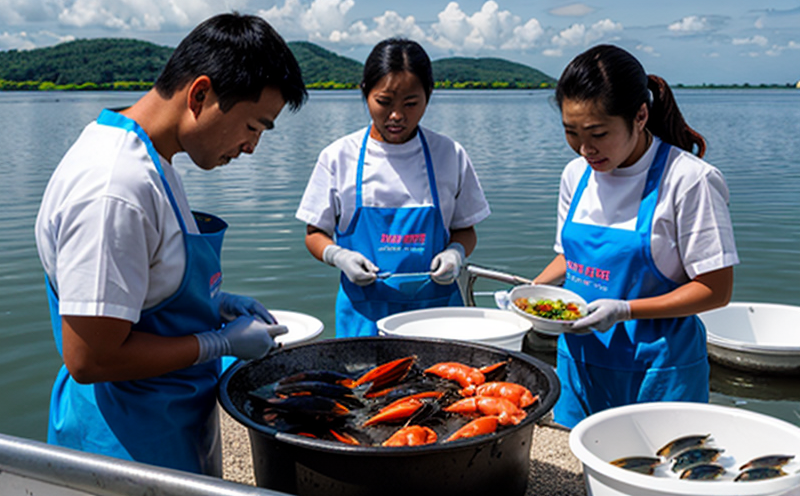ISO 16654 E. coli O157:H7 Detection in Seafood
The detection of pathogenic bacteria such as E. coli O157:H7 is critical for ensuring the safety and quality of seafood products. This standard, ISO 16654, provides a robust framework to identify this bacterium which can cause severe health issues including hemolytic uremic syndrome (HUS). In the context of global food safety regulations, accurate detection methods are essential to prevent outbreaks and maintain consumer trust.
The process involves several steps that ensure precision and reliability. Specimens must be collected from various parts of seafood products such as fish fillets, gills, or digestive tracts, depending on the part being tested. Each sample undergoes rigorous processing including homogenization to release any bacteria present for analysis.
The testing procedure typically begins with preliminary screening using a culture-based method, where samples are incubated under specific conditions favorable for growth of E. coli O157:H7. If colonies indicative of this strain appear after 24 hours (or longer if the initial screen suggests contamination), further confirmatory tests like serological techniques or molecular biology approaches such as PCR might be employed.
Using advanced technologies allows for more sensitive detection than traditional methods. Real-time qPCR assays, for example, can provide results within a few hours rather than days required by culture-based methods. These rapid tests are particularly valuable in food safety laboratories where quick turnaround times are necessary to inform corrective actions promptly.
While the standard provides guidelines on sample preparation and initial screening, it also emphasizes the importance of quality control throughout every stage of testing. Laboratories adhering strictly to ISO 16654 ensure consistent and reliable results that meet regulatory requirements set forth by organizations like the FDA or WHO.
The significance of accurate detection cannot be overstated; erroneous identification could lead to unnecessary recalls or potential spread of harmful organisms in food supplies. By employing this internationally recognized standard, our laboratory guarantees precision and efficiency in identifying E. coli O157:H7 within seafood products.
Scope and Methodology
The scope of ISO 16654 E. coli O157:H7 detection in seafood encompasses the entire process from sample collection to final confirmation of presence or absence of this pathogen. This includes detailed procedures for preparing samples, performing initial screenings, and employing confirmatory tests.
- Sample Collection: Specimens are taken from different locations within seafood items such as muscle tissue, viscera, and surface areas.
- Preparation: Samples undergo homogenization to ensure uniform distribution of potential pathogens for optimal detection.
- Initial Screening: Cultures are grown under controlled conditions; if positive results indicate possible contamination with E. coli O157:H7.
- Confirmatory Testing: Positive cultures undergo further analysis using techniques like PCR to definitively identify the strain.
- Data Analysis and Reporting: Results are compiled into reports detailing findings along with recommendations for action if contamination is detected.
Quality and Reliability Assurance
To maintain high standards of quality and reliability in our testing services, we implement stringent protocols at every step. This includes rigorous training programs for staff to ensure they are proficient in handling samples correctly and interpreting results accurately.
- Training Programs: Regular workshops focusing on the latest methodologies and best practices for accurate detection.
- Sophisticated Equipment Calibration: Ensuring all instruments used meet precise calibration standards before each use.
We also adhere strictly to ISO 16654, which mandates adherence to strict procedures and documentation requirements. This ensures transparency in our operations and builds confidence among clients about the accuracy of our results.
Customer Impact and Satisfaction
Our commitment extends beyond just meeting regulatory standards; we strive to provide value-added services that directly benefit our customers. By ensuring timely detection of harmful pathogens like E. coli O157:H7, we help prevent contamination incidents in the supply chain.
- Timely Reporting: Ensuring rapid dissemination of results allows for prompt implementation of corrective measures if necessary.
- Consultative Support: Offering expert advice on how to improve sanitation practices within production facilities based on our findings.
This proactive approach not only protects public health but also enhances brand reputation by demonstrating a strong commitment to food safety. Satisfied clients often become repeat customers, referring others to us due to the reliability and efficiency of our services.





